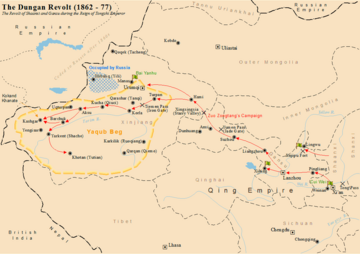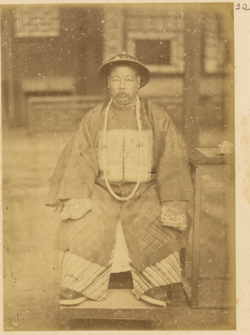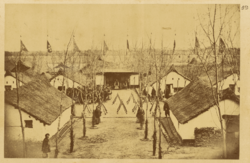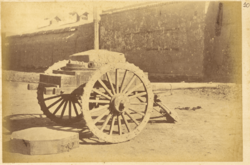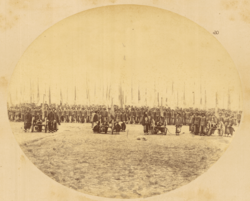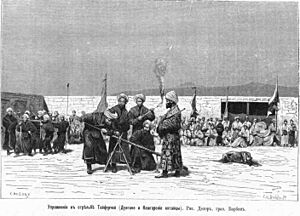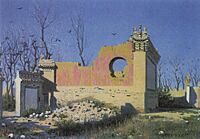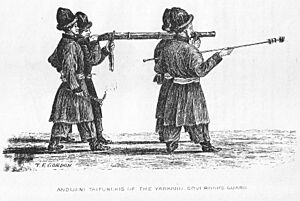Dungan Revolt (1862–1877) facts for kids
Quick facts for kids Dungan Revolt |
||||||||
|---|---|---|---|---|---|---|---|---|
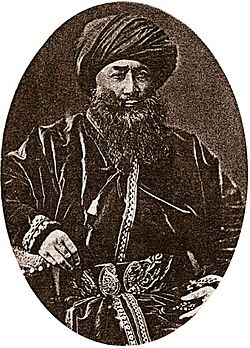 Yaqub Beg |
||||||||
|
||||||||
| Belligerents | ||||||||
|
Supported by: Hui Muslim loyalists Khufiyya order under Ma Zhan'ao in Gansu (1872–1877) Eleven Gedimu Battalions of Shaanxi (1872–1877)
|
Supported by: Taranchi Sultanate of Ili Dungan rebels in Yarkand Khotanese rebels Dungan rebels of Tacheng |
Hui Muslim rebels Gedimu Eighteen Shaanxi Battalions (Eleven of the Battalion leaders surrendered and defected to the Qing dynasty, six were killed, and one, Bai Yanhu, fled to Russia)
Jahriyya order under Ma Hualong in Gansu Khufiyya order under Ma Zhan'ao in Gansu (1862–1872) |
||||||
| Commanders and leaders | ||||||||
|
|
|
||||||
| Strength | ||||||||
| Hunan Army, 120,000 Zuo Zongtang army and Khafiya Chinese Muslim troops | Andijani Uzbek troops and Afghan volunteers, Han Chinese and Hui forcibly drafted into Yaqub's army, and separate Han Chinese militia | Rebels in Shaanxi and Gansu | ||||||
The Dungan Revolt (1862–1877) was a major war in western China during the Qing dynasty. It happened mostly when the Tongzhi Emperor was ruling (1861–1875). This revolt involved two main waves of uprisings by different Chinese Muslim groups, mostly Hui people. The first wave was in Shaanxi, Gansu, and Ningxia provinces. The second wave happened in Xinjiang. The Qing army, led by General Zuo Zongtang, eventually stopped the revolt.
The conflict started with fights and attacks between Hui people and Han Chinese. Then, the Han Chinese took revenge, leading to more violence. This caused huge changes in the population of Northwest China. Millions of people died from fighting, moving away, hunger, and sickness. For example, Gansu province lost a large part of its population. Many Hui people in Shaanxi were killed or forced to leave. Some Han people also moved to other areas after the war.
Hui people in Shaanxi faced harsh punishments from the Qing government because of local disagreements. Officials in Shaanxi wanted to use military force against the Hui rebels. But officials in Gansu wanted to be more forgiving. Han rebels, called Nian rebels, worked with the Shaanxi Hui rebels for a time. However, General Zuo Zongtang defeated the Nian rebels by 1868. The Hui rebels in Shaanxi then fled to Gansu in 1869. Some soldiers in the Qing army also rebelled, which slowed down the Qing's efforts.
The revolt began in the Wei River valley in Shaanxi, Gansu, and Ningxia. It was a confusing time with many different groups fighting. They did not have one clear goal. Many historians believe the rebels did not plan to overthrow the Qing government. Instead, they wanted to get revenge for unfair treatment. After the conflict, many Dungan people from Ili moved to the Russian Empire.
Contents
Understanding the Dungan Revolt
This section helps explain some of the words used in this article.
Who are the Dungan People?
In this article, "Dungan people" refers to Hui people. They are a group in China who are mostly Muslim and speak Chinese. They are sometimes called "Chinese Muslims." They are different from "Turkestanis" or "Turkic" people, like Uyghurs, Kazakhs, and Kyrgyzes.
Old Names for Groups
The group now known as Uyghur people was not called that before the 1900s. Before that, Uyghurs from the Tarim Basin were called "Turki." Uyghur people who moved from the Tarim Basin to Ili were called "Taranchi." The name "Uyghur" was given to them later by the Soviet Union in 1921. So, old writings about the Dungan Revolt do not mention "Uyghurs."
"Hui" was a Chinese name for Muslim people. But it specifically means Chinese-speaking Muslims in China who share many customs with the Han Chinese. Europeans often called these people "Dungan" or "Tungan" during the Dungan Revolt.
The people called "Andijanis" or "Kokandis" were from the Kokand Khanate. This included groups like Uzbeks and Southern Kyrgyzes. The Kokand army was mostly made up of Uzbeks and nomadic Kyrgyz.
Revolt in Gansu and Shaanxi Provinces
This part of the article explains how the revolt started and developed in these areas.
Why the Revolt Started
The Dungan Revolt happened partly because of disagreements between different groups of people. It was not just about religion, as some people might think.
Chinese Muslims had played a big role in fighting the early Qing dynasty. For example, in 1646, Muslim Ming loyalists in Gansu rebelled. They wanted to drive out the Qing and bring back the Ming emperor. Han Chinese and Tibetans also joined them. After much fighting, they made a peace deal. But when the Qing army left Gansu, the Muslims rebelled again. They were eventually defeated, and many were killed.
During the Qianlong era (1735–1796), there were clashes between the Qing government and a Muslim group called the Jahriyya Sufi sect. But they did not clash with other Muslim groups.
Muslim scholars from Gansu had traveled to West Asia to study. They brought back two different types of Sufism to northwest China: Khufiyya and the more radical Jahriyya. These groups had disagreements. Also, Qing officials were seen as corrupt. This led to smaller uprisings by followers of the New Teaching (Jahriyya) in 1781 and 1783. These were quickly stopped. These tensions contributed to the violent atmosphere before the Dungan Revolt.
How the Revolt Happened
In the spring of 1862, Taiping troops were near southeastern Shaanxi. Local Han Chinese, encouraged by the Qing government, formed groups to defend against them. Fearing these armed Han groups, the Muslims also formed their own groups.
Some historians say the Dungan Revolt began in 1862. It was not a planned uprising. Instead, it started with small fights and riots. There were also false rumors that Hui Muslims were helping the Taiping Rebels.
One event that led to the revolt was a fight over the price of bamboo poles. A Han merchant was selling them to a Hui person. After this fight, Hui groups attacked Han people and other Hui who did not join them. This small dispute seemed to start the full revolt. However, historical records show that Hui people were buying large amounts of bamboo to make spears. There had already been attacks on Han areas before this incident. Records suggest there were plans among the Hui to create an Islamic state in western China.
Because the Qing dynasty was weak and its armies were busy elsewhere, the revolt spread quickly in southeastern Shaanxi. By June 1862, organized Muslim groups surrounded Xi'an. Qing General Dorongga relieved Xi'an in late 1863. His forces defeated the Muslim rebels and pushed them out of Shaanxi into Gansu. Dorongga was later killed in 1864 by Taiping rebels.
Many Muslim refugees from Shaanxi fled to Gansu. Some formed the "Eighteen Great Battalions" in eastern Gansu. They wanted to fight their way back home. While the Hui rebels were getting ready to attack Gansu and Shaanxi, Yaqub Beg declared himself ruler of Kashgar. He soon took control of the Tarim Basin in Xinjiang.
In 1867, the Qing government sent General Zuo Zongtang to Shaanxi. He was a very skilled commander who had helped stop the Taiping Rebellion. Zuo wanted to bring peace to the region by supporting farming and traditional education. He needed money from outside Northwest China to do this.
Zuo Zongtang asked the government to use resources from the southeast to support his armies. He got loans from foreign banks to fund his plan to take back Gansu from the Dungan rebels. He also made sure he had plenty of supplies before starting his attack.
Ten thousand soldiers from the old Xiang Army were sent to Shaanxi to help General Zuo. He had already gathered a 55,000-man army in Hunan. They joined other armies from Sichuan, Anhui, and Henan.
Zuo's army included soldiers from Hunan, Sichuan, Anhui, and Henan, plus thousands of cavalry. The Hunan soldiers were very good at shooting and battlefield moves. Zuo's army also used Western-made guns.
The Lanzhou Arsenal was built in 1872 by Zuo Zongtang during the revolt. It made "steel rifle-barreled breechloaders" and provided ammunition.
The Muslim Jahriyya leader Ma Hualong controlled a large trading network. He used his wealth to buy guns. Zuo Zongtang suspected Ma wanted to control all of Mongolia.
General Liu Songshan died fighting against rebel forts. His nephew, Liu Jintang, took over. After stopping the revolt in Shaanxi and gathering enough food for his army, Zuo attacked Ma Hualong. General Liu Jintang led the siege, firing cannons at the town. The people inside had to eat grass to survive. Zuo's troops reached Ma's stronghold, Jinjibao, in September 1870. They used powerful Krupp siege guns. Zuo and Lai Ch'ang directed the artillery fire. They also used mines.
After a 16-month siege, Ma Hualong had to surrender in January 1871. Zuo sentenced Ma and over eighty of his officials to death. Thousands of Muslims were sent to other parts of China.
Zuo's next target was Hezhou (now Linxia), a main center for Hui people and a key trade point. Hezhou was defended by Ma Zhan'ao's Hui forces. Ma Zhan'ao was willing to make peace with the Qing government. When the revolt started, he helped Han Chinese escape to safety.
After successfully pushing back Zuo Zongtang's first attack in 1872, Ma Zhan'ao offered to surrender. He also offered to help the Qing. He was able to protect his Dungan community with his diplomatic skills. While Zuo Zongtang forced Muslims to move from other areas, in Hezhou, he moved non-Muslim Han people instead. This was a reward for Ma Zhan'ao and his Muslim troops helping the Qing. Linxia remains a heavily Muslim area today. Other Dungan generals, like Ma Qianling and Ma Haiyan, also joined the Qing side. Ma Anliang, Ma Zhan'ao's son, also helped Zuo Zongtang's Qing forces defeat the rebels. Dong Fuxiang also joined the Qing army.
Reinforced by the Dungan people of Hezhou, Zuo Zongtang planned to move west towards Xinjiang. But first, he needed to secure Xining. Xining had many Muslims, including refugees from Shaanxi. Xining fell after a three-month siege in late 1872. Its commander, Ma Guiyuan, was captured, and thousands of defenders were killed. The Muslim people of Xining were spared, but the Shaanxi refugees were moved to other parts of Gansu, away from other Muslim areas.
Many Muslims continued to fight at Suzhou (Jiuquan), their last stronghold in west Gansu. The city was led by Ma Wenlu. Many Hui people from Shaanxi were also in the city. After securing his supplies, Zuo Zongtang surrounded Suzhou in September 1873 with 15,000 troops. The city fell on October 24. Zuo had 7,000 Hui people executed. He moved the rest to southern Gansu. This was to make sure the entire Gansu Corridor would remain free of Hui people. This prevented future cooperation between Muslims in Gansu, Shaanxi, and Xinjiang. Han and Hui people loyal to the Qing took over the land of Hui rebels in Shaanxi.
Confusing Aspects of the Revolt
The rebels were not organized and did not have a common goal. Some Han Chinese also rebelled against the Qing. Rebel groups even fought each other. The main Hui rebel leader, Ma Hualong, was even given a military rank by the Qing dynasty at one point. Only later, when Zuo Zongtang began his campaign, did he decide which rebels would be executed or spared.
Zuo Zongtang generally killed New Teaching Jahriyya rebels, even if they surrendered. But he spared Old Teaching Khafiya and Sunni Gedimu rebels. Ma Hualong belonged to the New Teaching group, so Zuo executed him. However, Hui generals from the Old Teaching group, like Ma Qianling, Ma Zhan'ao, and Ma Anliang, were forgiven and even promoted in the Qing army. An army of Han Chinese rebels led by Dong Fuxiang also surrendered and joined Zuo Zongtang.
General Zuo accepted the surrender of Hui people from the Old Teaching group. They had to give up many weapons and agree to move. He refused to accept the surrender of New Teaching Muslims who still followed their beliefs. The Qing saw them as a dangerous group. Zuo said, "The only difference is between the innocent and rebellious, there is none between Han and Hui."
The Qing government said that the Hui rebels who used violence were just a small group of heretics. They were not typical of all Hui people. The Qing said there were two different Muslim groups: the "old" religion and the "new" religion. The new one was seen as wrong, like the White Lotus Buddhists. The Qing wanted to separate Muslim rebels by their group.
The Nature of the Revolt
During the revolt, some Hui people fought for the Qing from the beginning. A pro-Qing Muslim Hui leader named Wang Dagui was rewarded for fighting against Hui rebels. However, Wang Dagui and his family were later killed by other anti-Qing Hui rebels.
Also, the Hui Chinese rebel leaders never called for a holy war (Jihad). They never said they wanted to create an Islamic state. This was different from the Xinjiang Turki Muslims, who did call for Jihad. Instead of overthrowing the government, the rebels wanted to get revenge on local corrupt officials and others who had treated them unfairly.
When Ma Hualong first talked with the Qing in 1866, he agreed to surrender. He gave up thousands of foreign weapons, spears, swords, and 26 cannons. Ma even took a new name showing loyalty to the Qing. But his surrender did not stop the revolt from spreading.
Even after Ma Hualong was sentenced to death, Zuo canceled the execution when Ma surrendered a second time in 1871. Ma gave up all his weapons, including cannons and Western guns. Zuo also told him to convince other leaders to surrender. But Zuo then found a hidden stash of 1,200 Western weapons at Ma Hualong's base. Ma also failed to persuade others to surrender. After this, Ma, his male family members, and many of his officers were killed. Zuo then said he would accept the surrender of New Teaching Muslims who admitted they were misled.
Ma Zhanao and his son Ma Anliang joined the Qing during the Dungan rebellion. As mentioned, Zuo moved Han Chinese from Hezhou as a reward for Ma Zhan'ao. Zuo also moved Shaanxi Muslim refugees from Hezhou, allowing only native Gansu Muslims to stay. Ma Zhanao and his Hui forces then joined the Qing military.
Hui Muslims in Peaceful Areas
Hui Muslims living in areas not affected by the revolt were completely fine. They faced no restrictions and did not try to join the rebels. For example, the Hui Muslim population of Beijing was not affected by the Dungan Revolt.
The relationship between Hui Muslim and Han peoples in the Henan area continued normally. The major Muslim revolts in other areas did not directly affect Henan. A Hui Muslim officer named Ma Xinyi served the Qing dynasty during the Dungan Revolt.
The Hui Muslims of Xi'an city did not rebel against the Qing. They remained in Xi'an after the war. Xi'an's walls held strong against a rebel siege for two years (1870-1871) and did not fall.
During the Panthay Revolt, peace talks were held by Hui Muslims from Zhejiang and Sichuan. They were invited by the Qing to Yunnan in 1858 and were not involved in the revolt. The Qing dynasty did not kill Muslims who surrendered. The Muslim General Ma Rulong, who surrendered and joined the Qing, was promoted.
Hui loyalists and Han people took over the land of the Shaanxi Hui who had moved to Gansu.
Revolt in Xinjiang Province
This section describes the Dungan Revolt in the Xinjiang region.
Before the Revolt Started
By the 1860s, Xinjiang had been under Qing rule for about a hundred years. The Qing had conquered the area in 1759. Xinjiang was mostly dry land, so it did not attract many Han Chinese settlers, except for some traders. Other people, like Uyghurs, settled there. Xinjiang was divided into three main areas.
The overall military command was held by the General of Ili, stationed in Huiyuan Cheng. He also managed civilian affairs. However, the Eastern Circuit was managed by Gansu Province for civilian matters.
In 1765, the Ush rebellion happened in Ush Turfan. This rebellion was caused by bad rule and unfair treatment by the Qing after they took over Xinjiang in 1759.
During the Afaqi Khoja revolts, there were many attacks by Afaqi khojas from Kokand into Kashgaria. Because of these attacks, the government increased the number of troops in Xinjiang to about 50,000. Both Manchu and Han units were stationed there. The Han units, mostly from Shaanxi and Gansu, had many Hui (Dungan) soldiers.
Keeping this army was very expensive. The local economy could not pay for it, so the central government had to send money. This support became difficult by the 1850s and 1860s because of the costs of stopping the Taiping Rebellion and other revolts in China. The Qing officials in Xinjiang responded by raising taxes, adding new ones, and selling official jobs to people who paid the most. These new officials would then make people pay unfair taxes to get their money back.
Increased taxes and corruption made the people of Xinjiang more unhappy. They had already suffered from bad Qing officials and local leaders. Qing soldiers in Xinjiang were also not paid on time or given proper equipment.
When the revolt started in Gansu and Shaanxi in 1862, rumors spread among the Hui (Dungans) of Xinjiang. They heard that the Qing government was planning to kill all Hui people in Xinjiang. While the Tongzhi Emperor called these rumors "absurd," some Muslim historians believe that mass killings were indeed planned by local officials. So, the Dungans usually rebelled first in most Xinjiang towns. The local Turkic people—Taranchis, Kyrgyzs, and Kazakhs—would then quickly join them.
Many Revolts at Once
The first small revolt in Xinjiang happened on March 17, 1863. About 200 Dungans attacked Tarchi, one of the Nine Forts in the Ili Basin. They took weapons and killed soldiers. But they were soon defeated by government troops and killed.
The revolt broke out again the next year, 1864. This time, it happened almost at the same time in all three parts of Xinjiang. It was too big for the authorities to stop.
On June 3–4, 1864, the Dungans of Kucha rebelled. Local Turkic people soon joined them. The Han fort, which was inside the town, fell in a few days. Government buildings were burned, and many Han and Mongols were killed. Since no single Dungan or Turkic leader was strong enough, they chose Rashidin Khoja, a religious man, as their leader. Over the next three years, he tried to control the entire Tarim Basin. But his plans were stopped by Yaqub Beg.
Three weeks after Kucha, the revolt started in the Eastern Circuit. Dungan soldiers in Ürümqi rebelled on June 26, 1864. Their leaders were Tuo Ming and Suo Huanzhang. Large parts of the city were destroyed, and the Manchu fortress was surrounded. The Ürümqi rebels then moved west, taking the cities of Manas and Wusu.
On October 3, 1864, the Manchu fortress of Ürümqi also fell. The Manchu commander chose to die rather than surrender.
In late 1864, the Dungans of the Ili Basin in the Northern Circuit also rebelled. They were encouraged by the success of the Ürümqi rebels. They were also worried about being attacked by the local Manchu authorities. The Qing government fired the General of Ili, Cangcing, who was hated for being corrupt. His replacement, Mingsioi, tried to talk with the Dungans, but it did not work. On November 10, 1864, the Dungans rebelled in Ningyuan and Huiyuan. The local Taranchis (Turkic farmers) joined the revolt. When local Muslim Kazakhs and Kyrgyzs saw the rebels winning, they joined too. However, the Buddhist Kalmyks and Xibes mostly stayed loyal to the Qing.
Ningyuan immediately fell to the Dungan and Turki rebels. But a strong government force at Huiyuan made the rebels retreat after 12 days of heavy fighting. Local Han Chinese joined the Manchus. However, a Qing counter-attack failed. The imperial troops lost their cannons. With the fall of Wusu and Aksu, the Qing army in Huiyuan was cut off. Mingsioi had to send messages to Beijing through Russia.
The Qing forces in Huiyuan stopped another rebel attack on December 12, 1864. But the revolt continued to spread in the northern part of the province (Dzungaria).
For Chinese New Year 1865, the Hui leaders of Tacheng invited Qing officials and Kalmyk nobles to a mosque. They wanted to swear an oath of peace. But once inside, the Hui rebels took the city's weapons and started killing the Manchus. After two days, the Muslims controlled the town. The Manchus were surrounded in their fortress. With the help of the Kalmyks, the Manchus took back the Tacheng area by late 1865. This time, the Hui rebels were trapped in the mosque. The fighting destroyed Tacheng, and the remaining residents fled.
Both the Qing government and the officials in Kulja asked the Russians for help against the rebels. But the Russians were careful. They did not want to fully refuse China, but they also did not want to upset their own new Muslim subjects. They decided not to offer serious help to the Qing, except for training some Chinese soldiers and selling some grain. Russia's main goal was to protect its border and prevent the revolt from spreading into its own lands.
Meanwhile, Qing forces in the Ili Valley were not doing well. In April 1865, the Huining fortress fell to the rebels after a three-month siege. Its 8,000 defenders were killed.
Most of Huiyuan fell to the rebels on January 8, 1866. Most residents and soldiers died. Mingsioi, still holding out in the Huiyuan fortress, ran out of food. He sent a group to the rebels, offering to surrender if their lives were spared and they could remain loyal to the Qing. Twelve Manchu officials and their families left the citadel. The Hui and Taranchis allowed them to settle in Yining. However, the rebels did not accept Mingsioi's terms. They demanded he surrender immediately. Since Mingsioi refused, they stormed the citadel. On March 3, the rebels broke in. Mingsioi gathered his family and staff and blew up his mansion, dying under its ruins. This was the end of Qing rule in the Ili Valley for a time.
Yaqub Beg in Kashgaria
Muslim sources say that Qing officials in Kashgar had planned to kill local Dungans. They carried out a massacre in the summer of 1864. This weakened the Dungan group there, which might be why the revolt was not as successful in Kashgar as elsewhere. Although Dungan rebels took Yangihissar, they could not break into the Manchu forts or the walled Muslim city of Kashgar.
Unable to control the region alone, the Dungans and Kyrgyzs asked for help from Kokand's ruler, Alim Quli. Help arrived in early 1865. Buzurg Khoja, a religious leader, came to inspire the people. Also, Yaqub Beg, a young but well-known Kokandian military commander, arrived with a few dozen soldiers. These soldiers became known as Andijanis.
By the time Buzurg Khoja and Yaqub Beg arrived, the Kyrgyzs had already taken the Muslim town of Kashgar. But they had to let Buzurg Khoja live in the former governor's home. Yaqub Beg's forces stopped the Kyrgyzs from taking over. The Kyrgyzs then had to accept Yaqub's authority.
Yaqub Beg had a small but well-trained army of local Dungans, Kashgarian Turkic people, Kyrgyz allies, and his own Kokandians. He also had about 200 soldiers from Badakhshan. With this army, he took the Manchu fortress and the Han Chinese town of Kashgar in 1865. The Manchu commander in Kashgar blew himself up. Yaqub Beg also defeated a larger force from Rashidin of Kucha, who wanted to control the Tarim Basin.
While Yaqub Beg was taking control of Kashgaria, things changed in Kokand. In May 1865, Alim Quli died defending Tashkent against the Russians. Many of his soldiers fled to Kashgaria for safety. They arrived at Yaqub Beg's borders in early September 1865. Afghan warriors also helped Yaqub Beg.
Yaqub Beg's rule was not popular with the local people. One local Kashgari said, "During the Chinese rule there was everything; there is nothing now." Trade also decreased.
Yaqub Beg Fights the Dungans
Taranchi Turkic Muslims in Xinjiang first worked with the Dungans (Hui people) when they rebelled. But they later left them after the Hui tried to control the whole region. The Taranchi killed many Dungans at Kuldja and forced the rest to flee to the Ili Valley.
The Hui people in Xinjiang were not trusted by either the Qing government or the Turkestani Muslims.
Yaqub Beg's Kokandi Uzbek forces declared a holy war against Dungan rebels led by T'o Ming. Fighting broke out between Dungan and Kokandi Uzbek rebels in Xinjiang. Yaqub Beg used Han Chinese militia under Xu Xuegong to fight against T'o Ming's Dungan troops. T'o Ming's Dungan forces were defeated at the Battle of Urumqi (1870). This was part of Yaqub Beg's plan to conquer Dzungaria and take all Dungan territory.
Yaqub Beg took Aksu from Dungan forces and forced them north of the Tian Shan. He also carried out mass killings of the Dungan people.
Independent Han Chinese militia, not part of the Qing government, joined both Yaqub Beg's Turkic forces and the Dungan rebels. In 1870, Yaqub Beg had 1,500 Han Chinese troops with his Turkic forces attacking Dungans in Ürümqi. The next year, the Han Chinese militia joined the Dungans in fighting against Turkic forces.
Yaqub Beg's Foreign Relations
Russia and Britain signed agreements with Yaqub Beg's government in Kashgar. Yaqub wanted help from Britain and Russia for his government.
Relations with Russia
Yaqub Beg's relations with the Russian Empire changed between fighting and peaceful talks. The Russians did not like the people of Kashgar because their leaders were close to the Kokand Khans, whom Russia had recently defeated. This made it hard for Yaqub Beg to get much help from Russia.
Support from the Ottoman and British Empires
The Ottoman Empire and the British Empire both recognized Yaqub Beg's state. They sent him thousands of guns. British diplomats visited Kashgar in 1868 and 1870. This made Britain interested in Yaqub's government, and they signed a trade agreement with him in 1874.
Qing Takes Back Xinjiang
The Qing decided to take back Xinjiang in the late 1870s. Zuo Zongtang, a general from the Xiang Army, led all Qing troops in this effort. His main helpers were the Han Chinese General Liu Jintang and Manchu Jin Shun. As Zuo Zongtang moved into Xinjiang to defeat the Muslim rebels under Yaqub Beg, he was joined by Dungan (Hui) General Ma Anliang and General Dong Fuxiang. Qing forces entered Ürümqi without a fight. Yaqub's leaders left him or fled as his forces fell apart. The cities fell easily to the Qing troops.
The rebel army kept shrinking as they retreated. Yaqub Beg lost more than 20,000 men, either because they left his army or were killed. In October 1877, after Yaqub Beg died, Jin Shun continued his advance and met no strong resistance. General Zuo reached Aksu, a key city for Kashgaria in the east. Its commander left his post right away. The Qing army then moved to Uqturpan, which also surrendered easily. In early December, all Qing troops began their final attack on the capital city of Kashgaria. The rebel troops were defeated and fled to Russian territory. With the fall of Kashgaria, the Qing had fully taken back Xinjiang. There were no more revolts, and the Qing government began to rebuild and reorganize the area, creating the Xinjiang province in 1884.
The use of Muslims in the Qing armies against the revolt was noted by Yang Zengxin. He wrote that Dungan troops were very effective. He also mentioned that Muslim troops and generals helped stop the Muslim revolt in Yunnan. This showed that Muslim troops could be used well, even during Muslim uprisings.
Han Chinese soldiers and travelers bought Turki Muslim (Uyghur) girls as wives from their parents after Zuo Zongtang took back Xinjiang. Han and Uyghurs often used Hui people to help translate and arrange these marriages.
After the Revolt Ended
This section explains what happened after the Dungan Revolt was put down.
Punishments for Rebels
When the Qing forces under Zuo Zongtang stopped the Dungan Revolt, the sons of Muslim Hui and Salar rebel leaders were made servants for Qing armies in Xinjiang. The wives of the rebel leaders were also taken as servants. The Muslim rebels themselves were executed.
Yaqub Beg's family members who survived included his four sons, four grandchildren, and four wives. They either died in prison or were killed by the Qing government. His sons and grandsons who were captured were very young. They were put on trial and faced harsh sentences if they were found to have helped their father's rebellion. If innocent, they were to become servants for the Qing troops.
Remembering the Victims
On January 25, 1891, a temple was built by Liu Jintang. He was one of the generals who fought in the Dungan Revolt. The temple was built in the capital of Gansu to remember the 24,838 victims who died during the revolt in Kashgaria and Dzungaria. These victims included officials, farmers, and people from all groups. Another temple was already built to honor the Xiang Army soldiers who fought.
Hui People Move to Russia
The failure of the revolt led some Hui people to move to the Russian Empire. Three groups of Hui people fled to Russia during the very cold winter of 1877-1878.
- The first group of about 1,000 people from Turpan in Xinjiang reached Osh in southern Kyrgyzstan.
- The second group of 1,130 people from Gansu settled in the village of Yardyk near Karakol in Eastern Kyrgyzstan.
- The third group, from Shaanxi and led by Bai Yanhu, settled in the village of Karakunuz (now Masanchi) in Kazakhstan. This group had 3,314 people.
Another group of Hui people moved in the early 1880s. A treaty signed in February 1881 allowed Hui and Taranchi (Uyghur) people in the Ili Basin to move to the Russian side of the border. Most chose to do so. About 4,682 Hui people moved to the Russian Empire under this treaty. They settled in different places in southeastern Kazakhstan and northern Kyrgyzstan.
The descendants of these rebels and refugees still live in Kyrgyzstan and nearby parts of Russia, Kazakhstan, Tajikistan, and Uzbekistan. They still call themselves Hui people, but outsiders know them as Dungan.
More Power for Hui Military Leaders
The revolt increased the power of Hui generals and military men in the Qing Empire. Many Hui generals who served in the campaign were promoted by the Emperor, including Ma Anliang and Dong Fuxiang. This led Hui armies to fight again in the Dungan Revolt (1895-1896) against rebels, and in the Boxer Rebellion against Western armies.
Ma Fuxiang, Ma Qi, and Ma Bufang were descendants of these Hui military men. They became important generals in the Republic of China army. These pro-Qing Hui leaders became powerful by fighting against Muslim rebels. The sons of the Muslim leaders who joined the Qing during the Dungan Revolt (1862–1877) helped the Qing stop the Muslim rebels in the Dungan Revolt (1895–1896).
Border Dispute with Russia
After General Zuo Zongtang defeated the rebels, he demanded that Russia return the city of Kuldja in Xinjiang, which they had taken over. Zuo openly called for war against Russia and wanted to attack Russian forces in Xinjiang. In 1878, tensions grew. Zuo gathered Qing troops near Russian-controlled Kuldja. Chinese forces also fired on Russian groups, making them retreat.
Russia was in a difficult position with China. Russia feared a military conflict, which forced them into talks.
A Chinese official named Wanyan Chonghou was sent to Russia to negotiate a treaty. But even though China was in a stronger position, the Treaty of Livadia was very bad for China. It gave Russia part of Ili, special rights, consulates, control over trade, and a payment. This caused a huge outcry in China, and people demanded the government fight Russia. The government then gave important jobs to officers from the Xiang Army.
Russia refused to negotiate again unless Chonghou's life was spared. China did not want to accept the Livadia treaty or fight again, so they agreed. Zeng Jize became the new negotiator. Despite the anger caused by the first treaty, the new Treaty of Saint Petersburg was only slightly different. China got back almost all of Ili, but the payment to Russia was higher.
Western Explorers
Ney Elias traveled through the areas where the revolts happened.
Hui Muslims During the 1911 Revolution
During the Dungan Revolt, the Hui Muslims of Xi'an city did not rebel against the Qing. They refused to join the rebels. However, the Hui Muslims of Gansu rebelled under General Ma Zhan'ao and his son Ma Anliang before they joined the Qing.
The Hui Muslim community was divided in its support for the 1911 Xinhai Revolution. The Hui Muslims of Xi'an supported the revolutionaries. The Hui Muslims of Gansu, led by General Ma Anliang, supported the Qing. The Hui Muslims of Xi'an joined the Han Chinese revolutionaries in a violent event where many Manchu people in Xi'an city were killed. Only some wealthy Manchus who were paid for, and Manchu females, survived. Young Manchu women were taken by Han Chinese soldiers as wives, and some young Manchu girls were taken by Hui Muslims of Xi'an and raised as Muslims.
See also
- Dungan Revolt (1895–1896)
- Islam during the Qing dynasty
- List of rebellions in China
- Taiping Rebellion
- Nian Rebellion
- Miao Rebellion (1854–1873)
- Panthay Rebellion
- Punti–Hakka Clan Wars
- Nepalese-Tibetan War


